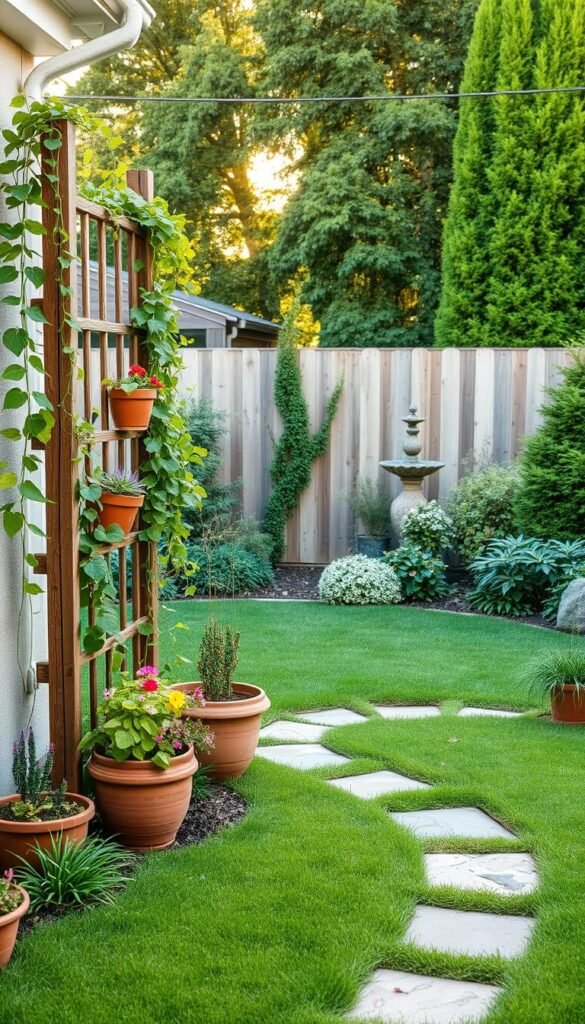Limited square footage doesn’t mean sacrificing lush greenery or fresh harvests. By reimagining how you use vertical surfaces and portable planters, you’ll unlock hidden potential in even the most compact areas. This approach lets you grow vibrant flowers, aromatic herbs, and juicy tomatoes without needing sprawling beds.
Climbing plants become your best allies here. Evergreen vines like jasmine create natural privacy screens, while flowering varieties add seasonal color. Creative structures – from repurposed ladders to sleek metal grids – turn blank walls into living art. Pair these with containers that fit your style, whether modern self-watering pots or rustic wooden crates.
Recent studies show smart setups boost yields dramatically. For example, basil grown in space-efficient vertical systems produces 30% more leaves than traditional methods. You’ll also save time through easier access and reduced pest issues – some gardeners report 40% fewer bugs when elevating plants.
This isn’t just about productivity. Thoughtful arrangements make your area feel larger while creating peaceful retreats. In fact, 68% of urban growers say combining greenery with functional elements lowers stress. Whether you’re working with a balcony or narrow side yard, these techniques help craft an oasis that nourishes both body and soul.
Getting Started with Vertical Gardening in Small Spaces
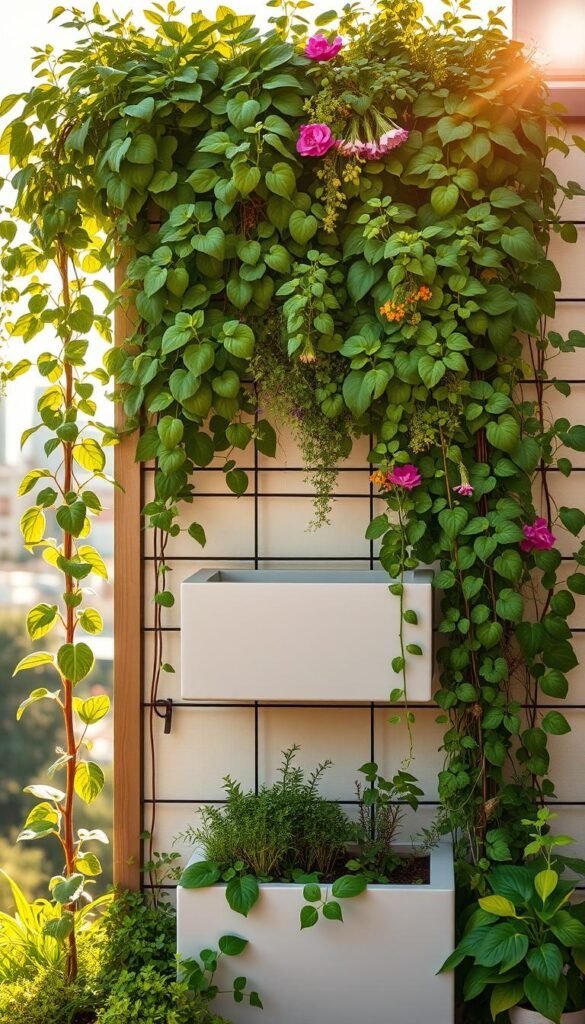
Maximize every inch by growing upwards, perfect for tight spots. Vertical systems let you work smarter, not harder, turning unused walls and fences into productive zones. Whether you’re growing herbs or cascading flowers, this method adapts to your needs while keeping maintenance simple.
Understanding the Benefits of Vertical Gardening
Why stack plants upward? Research shows vertical setups increase yields by 50% compared to ground planting. Airflow improves, reducing mold risks. Pests like slugs struggle to reach elevated crops, giving your tomatoes and beans a fighting chance.
Harvesting becomes effortless when strawberries dangle at waist height. One gardener shared:
“I save 15 minutes daily just by avoiding constant bending.”
Plus, these living walls create natural shade for heat-sensitive plants below.
Assessing Your Available Space and Sunlight
Start by mapping sunlight patterns. Use a free app or simply observe where shadows fall. Most edibles need 6+ hours of direct light. South-facing walls often work best, but east-facing spots suit leafy greens.
Check structural strength – a trellis loaded with wet soil and mature plants can weigh 20+ pounds. Test surfaces by hanging a weighted bag first. For quick wins, try colorful container gardening flowers on sturdy shelves before committing to wall-mounted systems.
Innovative Trellis Ideas for Compact Gardens
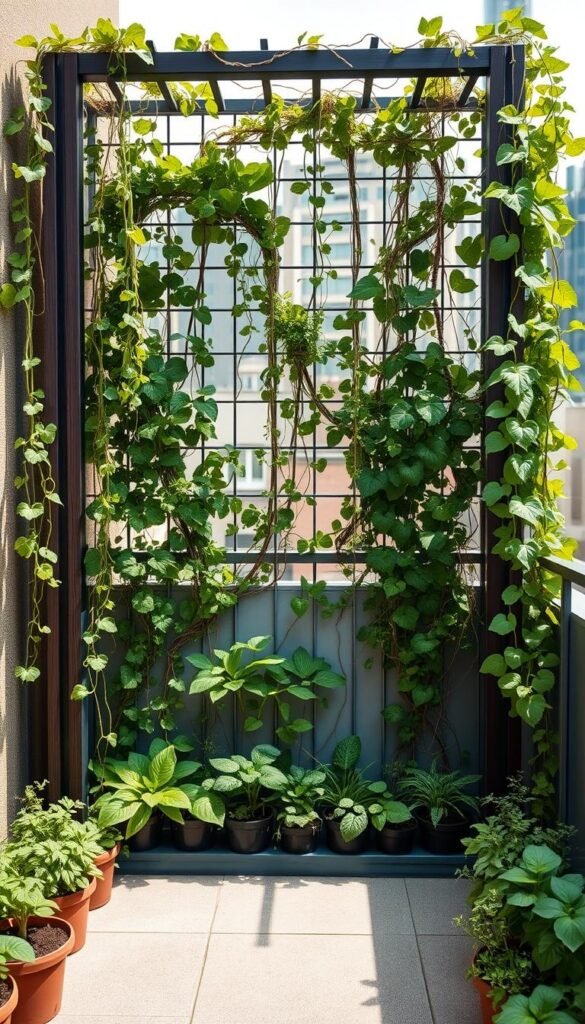
Unlock hidden potential in tight corners by exploring versatile trellis solutions. These structures blend form and function, offering endless customization through material choices and patterns. Whether crafting a rustic vibe or modern elegance, your options stretch far beyond basic grids.
DIY Trellis Projects vs. Ready-Made Options
Handmade creations let you tailor designs to exact needs. Bamboo poles tied with twine make sturdy frames for peas or cucumbers. Upcycled ladders become instant climbing supports – just lean them against walls. For quick fixes, attach chicken wire to wooden posts using staple guns.
Pre-built choices save time while delivering polished looks. Powder-coated metal grids withstand harsh weather, ideal for wisteria or grapes. Expandable willow panels adapt to changing plant sizes. One gardener noted:
“My store-bought arch trellis doubled as a shaded reading nook when covered in ivy.”
Consider these factors when deciding:
- Durability: Metal lasts longer than untreated wood
- Cost: DIY cuts expenses by 60-80%
- Style: Geometric patterns suit contemporary spaces
For beginners, DIY trellis projects using bamboo offer low-risk experimentation. Advanced growers might invest in modular systems that connect multiple panels. Either way, proper placement ensures plants get ample light while enhancing your area’s visual flow.
Container Tactics for Maximizing Your Garden Layout
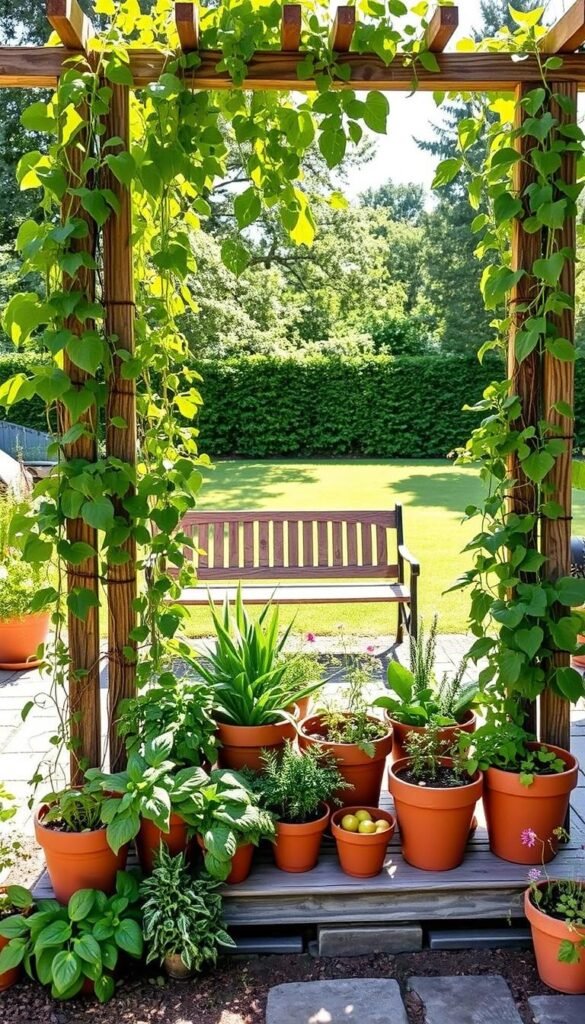
Transform your growing area with smart container strategies that combine beauty and function. Pairing pots with vertical elements creates dynamic displays while conserving ground space. Let’s explore how to match your greenery with structures that enhance growth and visual harmony.
Selecting the Right Containers for Climbing Plants
Choose pots that balance depth and stability – shallow roots thrive in 12-inch-deep containers, while heavy climbers need 18+ inches. Terra cotta breathes well but dries quickly; glazed ceramic retains moisture for thirsty varieties like clematis. One urban gardener reported:
“My jasmine tripled in size after switching to self-watering boxes with built-in drainage trays.”
Integrating Trellises with Your Container Arrangements
Attach lightweight metal grids to wooden troughs using waterproof brackets – this combo withstands wind while showcasing blooming vines. For quick updates, slide expandable panels into existing pots. Consider these pairings:
- Rustic willow trellises with weathered zinc planters
- Powder-coated steel frames alongside modern fiberglass containers
- Bamboo tripods in colorful ceramic urns
Match structure heights to plant potential – morning glory needs 6-foot supports, while compact peas manage 3 feet. Stagger containers at different levels using risers or shelves to create depth. This layered approach lets sunlight reach all leaves while turning functional setups into eye-catching features.
Small Backyard Garden Layout Solutions: Vertical Trellises and Container Tactics
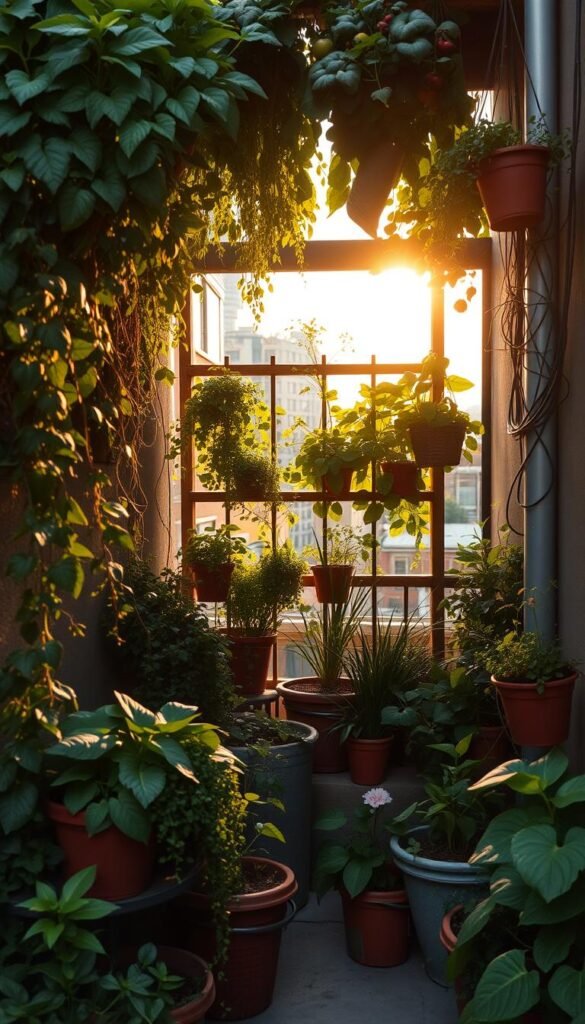
Even the tiniest nooks can burst with life when you grow upward, not outward. By focusing on vertical surfaces and portable containers, you convert underused walls and fences into lush, productive zones. This method isn’t just about saving space—it’s about redefining what’s possible in compact environments.
Why This Approach Works for Tight Spaces
Vertical gardening flips the script on spatial limitations. Instead of fighting for ground area, you’ll harness walls, railings, and airspace. Research shows this strategy triples usable growing zones compared to traditional setups. One urban farmer shared:
“My 12-foot fence now yields more beans than my old 100-square-foot plot ever did.”
The secret lies in three-dimensional thinking. Stacked containers and climbing systems create distinct microclimates—sun-loving tomatoes up top, shade-tolerant herbs below. You’ll maximize every cubic foot while keeping pathways clear. For more ideas on maximizing small garden layouts, explore these clever strategies.
Flexibility shines through seasonal adjustments. Swap spring peas for fall gourds on the same trellis. Rotate containers to chase sunlight patterns. This adaptability makes your setup future-proof, whether you’re expanding your plant collection or testing new varieties.
Repurposing Materials for Affordable Vertical Garden Structures
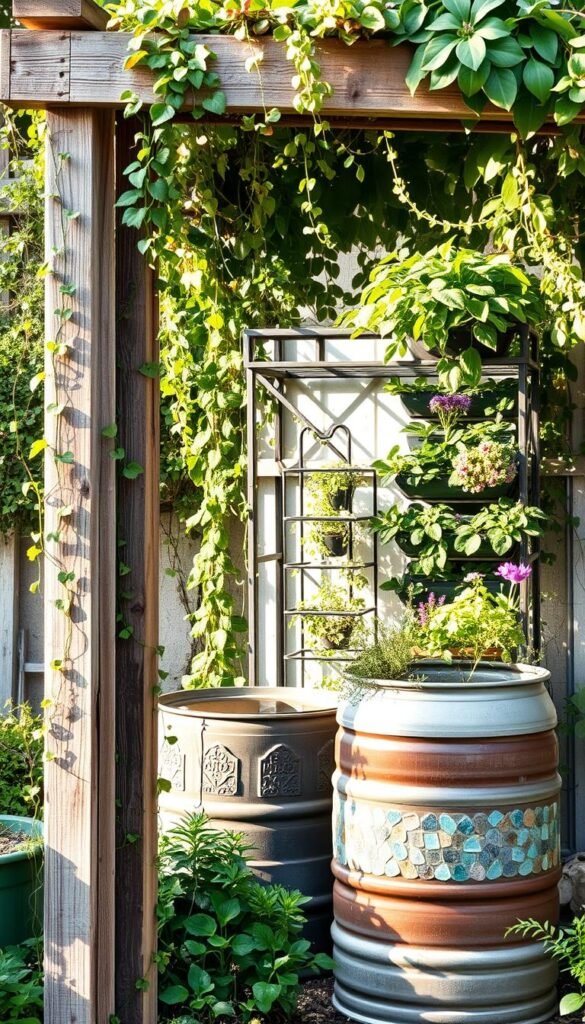
Turn everyday objects into garden gold with clever material reuse. By reimagining common household items, you build functional growing systems without breaking the bank. This approach blends sustainability with smart design, turning overlooked resources into thriving plant displays.
Using Wood Pallets, Window Boxes, and Upcycled Items
Wood pallets become instant vertical planters when secured to walls. Add flowerpot rings to horizontal slats for herb displays, or attach shelves between boards for multi-level arrangements. One gardener transformed vintage window boxes into hanging strawberry towers by linking them with chains:
“My morning coffee ritual now includes plucking berries from my kitchen window.”
Creative Hacks with Chicken Wire, Ladders, and Bamboo
Stretch chicken wire across old picture frames to create lightweight climbing panels. Convert leaning ladders into tiered stands for container gardening ideas, using rungs as shelves. Bamboo poles offer natural support – lash them into teepees for beans or weave through balcony rails for privacy screens.
Focus on durability when repurposing. Seal wooden surfaces with weatherproof stain, and drill drainage holes in upcycled containers. These low-cost solutions prove great gardens don’t require fancy equipment – just creativity and materials you already own.
Seasonal Planning and Plant Choices for Vertical Success
Crafting a thriving vertical garden starts with smart plant selection that dances with the seasons. By pairing fast-growing annuals with sturdy perennials, you’ll maintain visual appeal while maximizing harvests. This rhythm keeps your space lively through temperature shifts and daylight changes.
Best Plants and Vegetables for Year-Round Growth
Evergreen climbers like star jasmine form lush backdrops that outlast frost dates. For winter interest, try Clematis cirrhosa ‘Wisley Cream’ – its creamy flowers bloom when most plants sleep. One gardener raved:
“My December mornings now feature fragrant blooms outside the kitchen window.”
Warm-weather stars include pole beans and indeterminate tomatoes. These vegetables climb eagerly, producing heavy yields in limited areas. Pair them with sweet peas for spring color bursts or vining squash for autumn harvests.
| Plant | Season | Key Benefit |
|---|---|---|
| Clematis | Year-round | Winter blooms |
| Jasmine | Summer | Scented flowers |
| Pole Beans | Summer | High yield |
| Sweet Peas | Spring/Fall | Fast coverage |
Rotate crops strategically. Plant cold-hardy peas in early spring, then switch to heat-loving cucumbers. This staggered approach ensures continuous production. For scent and pollinators, add honeysuckle – its tubular flowers attract hummingbirds while masking urban noises.
Remember support needs. Heavy squash requires sturdy trellises, while delicate sweet peas thrive on lightweight nets. Match your climbing varieties to structure strength for worry-free growth.
Enhancing Privacy with Trellis Screens and Divided Garden Areas
Discover how trellis enhancements can redefine your outdoor experience while boosting functionality. These versatile structures do more than support plants—they craft intimate spaces and soften harsh lines. A well-placed screen or decorative topper turns basic boundaries into dynamic features that evolve with your needs.
Using Trellis Toppers to Add Privacy and Style
Extend existing fences or walls with eye-catching toppers that serve dual purposes. Wave-shaped designs or arched trellis panels add height while creating climbing space for clematis or passionflower. One gardener transformed their chain-link fence into a floral curtain using curved metal grids: “Neighbors now compliment my ‘living artwork’ instead of staring into my yard.”
Evergreen vines like ivy ensure year-round coverage. Pair them with seasonal bloomers for layered interest—think jasmine for summer scent and Virginia creeper for autumn color. This approach maintains privacy while keeping your space visually engaging.
Screening Unattractive Features with Clever Design
Hide utility zones or storage areas without sacrificing style. Position free-standing trellis screens near compost bins or AC units, then train fast-growing roses or honeysuckle across them. These living barriers absorb noise and create pleasant microclimates.
For narrow spaces between buildings, install slim panels with horizontal slats. They block views while allowing airflow—perfect for urban settings. As one homeowner noted: “My trash cans disappeared behind a wall of climbing hydrangeas, and the alley now smells like a forest.”
Ready to maximize your garden’s potential? Start with one strategic screen or topper, then expand as your vision grows.

